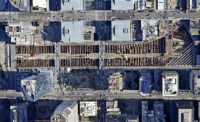Doyle Drive, part of U.S. Highway 101, provides access to and from the Golden Gate Bridge above the historic Presidio National Park in San Francisco. Erected in 1936 on a pair of viaducts, Doyle Drive was one of the country's most seismically unsafe structures.
The goal of this $90-million project, the third in a series of Caltrans contracts near the iconic bridge, was to remediate the seismic problem. The project broke ground in January 2010 and was completed in December 2011.
Scope included constructing the southbound Presidio Parkway viaduct to carry Highway 101 traffic and an on-ramp from northbound Highway 1 to southbound 101; and replacing existing structures on Highway 1, the Ruckman Avenue undercrossing and the northbound Highway 101 to the southbound Highway 1 off-ramp.
"Our challenges included working in a national park, meeting the needs of multiple agencies/stakeholders, coordination with the adjacent Doyle Drive tunnel project, large-diameter and deep-drilled foundations, working over the pet cemetery without disturbing it and incorporation of major utility lines into the work," says Bob Coupe, Northern California operations manager for the general contractor, C.C. Myers Inc., Rancho Cordova.
The cemetery, with grave markers dating to the 1950s, contains the remains of many pets of the servicemen and women stationed at the Presidio when it was a military base. To protect the site, the C.C. Myers team built a false deck over the structure on oversized girders 105 ft long by 8 ft deep.
The project contains many challenging design elements. For instance, the Presidio Viaduct—the largest structure—and its connecting on-ramp contain unique steel fins designed to hold the structural load of massive 14-ft overhangs. Each overhang weighs more than 2,200 lbs. They are spaced at 14-ft increments. Because of this structural feature, the fins needed to be redesigned midway through the project.
The viaduct, more than 1,300 ft long, has box girders as deep as 12 ft 9 in. Its foundation includes 12-ft-diameter piles installed to a depth of 200 ft. Because the historic Presidio of San Francisco buildings are nearby, the pile casings were installed using a 180,000-lb rotating oscillator to eliminate vibration and minimize effects on the historic and natural resources.
Coupe says, "To make this project such a success, multiple subcontractors worked together with C.C. Myers Inc., Caltrans, The Presidio Trust, the city of San Francisco, the National Park Service and other stakeholders in a coordinated effort to complete a highly complicated bridge project through a sensitive National Park—without significant disruption to the everyday lives of the local residents and those utilizing the natural resource of the park."
Doyle Drive Contract 3
San Francisco
Key Players
Owner: California Dept. of Transportation, San Francisco
Contractor: C.C. Myers Inc., Rancho Cordova
Lead Design: California Dept. of Transportation
Structural/Civil Engineer: California Dept. of Transportation
AC Paving, Excavation, Storm Drain: Bay Cities Paving & Grading, Concord
Structural Concrete: California Caissons & Shoring, San Jose
Paving: Cooper-Myers JV, Corona
Underground Utilities: Ghilotti Bros. Contractors, San Rafael
Rebar: Harris Salinas Rebar, Livermore
Electrical: Roadway Engineering Works, Middletown
Submitted by C.C. Myers Inc.





